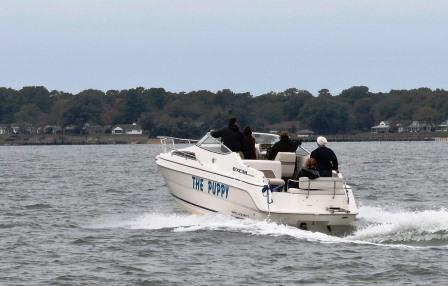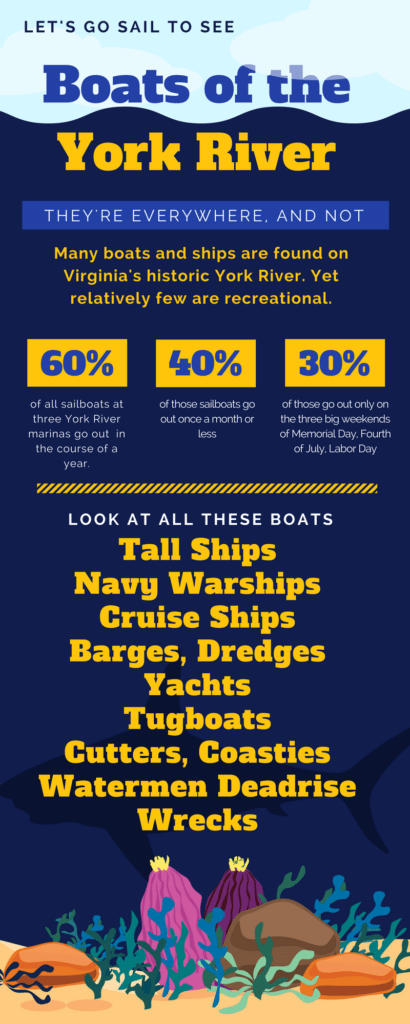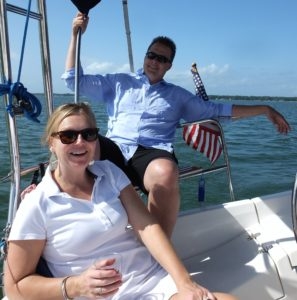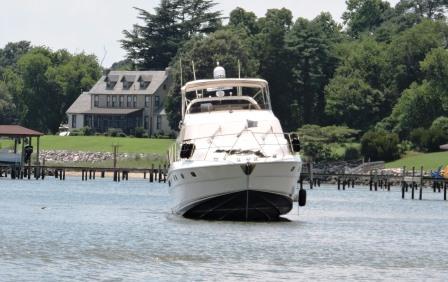At least once a week on the water, I’m asked about the feud between sailboats and motorboats. Do we resent their speed, arrogance, lack of manners, close calls, big wakes, loud music, etc.?
Actually, no, because while motorboats certainly go faster, their owners are relatively humble, quite polite, deferential, and observant of the mariner Rules of the Road.
There are plenty of boats out there to watch out for, everything from runabouts and tugs to mega-yachts and Navy warships.
As for recreational boaters, the older the owner, the better. They reflect the maturity that comes with having learned many lessons after numerous mistakes out on the water.
Younger boaters tend to cut across sailboat bows, which is a no-no under the Rules. When approaching another boat closely, take his stern. Young boaters also forget to take their fenders in from the sides of the boat. That’s fine with us sailors because it’s a sign the fellow is something of a student driver. We steer clear.
Large motorboats are much more careful with everyone, especially sailors. A boat that costs $500,000 is nothing to fool around with. These operators know the Rules and pay the liability insurance to prove it. They also realize that most sailors are more adroit on the water than motorboat operators because sailing simply takes more skill to maneuver.
Experienced boaters of both stripes are familiar with the “collision course” or “constant bearing, decreasing speed.” A quick visual on the horizon verifies the course and leads to deviation to avoid getting too near. Contact on marine radio via Channel 16 and 17 helps confirm what both skippers intend.
Things are pretty tame out on the York River, even when dozens of boats show up on the three big summer weekends. It gets dicey sometimes when numerous boats head back into the channel for Sarah Creek and the marina. Skippers slow down, douse their sails early, extend the fenders, and then give way accordingly to less-maneuverable boats.
The worst situation arises after the Fourth of July fireworks at Yorktown. Dozens of boats converge on the channel at 9:30 pm. While the skippers are presumed to be sober, I’ve seen drunk passengers fall over the side. That makes for a challenging man-overboard drill. An occasional boat runs hard aground on the sandbar, which is a sight to see the next morning.
Close Encounters with Recreational Boats
Professional Mariner magazine reports a rise in dangerous incidents between recreational and commercial vessels on US waterways. Think kayak vs. barge and you get the idea.
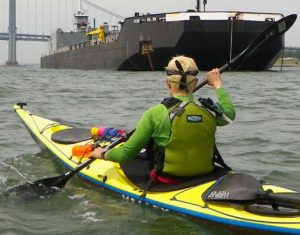 During 2014-16, “there were 93 marine casualty investigations where a commercail vessel was involved in an incident with a recreational vessel, involving 223 vessels of both types,” the magazine reports. Severa patterns emerged:
During 2014-16, “there were 93 marine casualty investigations where a commercail vessel was involved in an incident with a recreational vessel, involving 223 vessels of both types,” the magazine reports. Severa patterns emerged:
-
57 of the 93 incidents occurred in harbors and rivers.
-
The worst places were on the Columbia and Willmette rivers near Portland and Long Beach Harbor, Santa Barbara and San Diego in California.
-
Most incidents involved towing industry vessels and small passenger vessels.
-
In 2015 alone, USCG reported 4,158 recreational boating accidents resulting in 625 deaths, 2,613 injuries and $42 million in property damage.
-
Accidents in 2015 broke down as follow: 990 collisions with recreational vessels, 470 allisions with fixed objects, 449 flooding and swamping, 350 groundings, and 301 skier mishaps.
Sailing with a Submariner
 A family of five from Raleigh NC went sailing on the York River as an outing for their son, who’s attending nearby Christopher Newport University. Marcelo Anderson said that all three kids had attended sailing camp, so I put their CNU son Ethan to work turning the Genoa sheets. Marcelo held the helm the entire three hours as we tacked downriver in brisk 10 mph winds. Cheryl Anderson said, “I sailed with my dad on a 18-foot Hobie in California, so I’ve had a little experience.” The kids learned at Camp Don Lee on the Neuse River by sailing Sunfishes and Flying Scots. Ethan said, “We sailed the Scots on the sound off the Outer Banks.”
A family of five from Raleigh NC went sailing on the York River as an outing for their son, who’s attending nearby Christopher Newport University. Marcelo Anderson said that all three kids had attended sailing camp, so I put their CNU son Ethan to work turning the Genoa sheets. Marcelo held the helm the entire three hours as we tacked downriver in brisk 10 mph winds. Cheryl Anderson said, “I sailed with my dad on a 18-foot Hobie in California, so I’ve had a little experience.” The kids learned at Camp Don Lee on the Neuse River by sailing Sunfishes and Flying Scots. Ethan said, “We sailed the Scots on the sound off the Outer Banks.”
Let’s Stop This Sailing Feud
Later, three couple from the local area went out on a beautiful afternoon in steady 10 mph winds. We replicated the earlier cruise, including flying the spinnaker downwind for several miles. Amy Lerner paid for the cruise as a surprise birthday gift to her husband Peter. I suggested to him that it was better than finding out he was going skydiving. “I’ve done that too,” he replied. He’s retired US Army Reserve.
The group kept referring to their friend Erik Carlson as Rabbi, so I asked Amy what their group connection was. “We all worship together as Jews for Jesus. I know that sounds like an oxymoron, but you know that Jesus was a Jew.”
Erik wore an equally provocative T-shirt that read, “I Spent Most of My Adult Life on Ships that Sunk on Purpose, and You Expect Me to Act Normal?” He was a submariner in the US Navy, now retired and living in nearby Seaford. It was so nearby that we sailed right past it. “I sailed here only once in my career,” he said, referring to the Yorktown Naval Weapons Station. I asked about the current protocol of not opening the Coleman Bridge for submarines.
“It depends on the height of the tide, the current, and the bridge itself. We draw 28-1/2 feet, which requires some depth. You don’t want to be on the surface in a storm, because it’s just a tube and it rolls back and forth something awful.” I asked about chronic seasickness, and he said submariners get used to it. What about claustrophobia? “That’s worse They screen out 90 percent of the men who have it, but some invariably slip through. We had one guy go ballistic and had to take him back to port.” Wy=hy not just sedate him instead? “Good question.”
In 1992 Eric jumped on a boat in San Diego to sail out and watch the America’s Cup near one of the turning marks. On the way back in, “We passed Cabrillo Point and suddenly lost our wind. We looked up and found that the wind was blocked by the passing of the USS Abraham Lincoln, one of the largest aircraft carriers in the world. It was build here in Newport News and was arriving in the home port of the Sixth Fleet for the first time. Oh my God, the security boats were everywhere, blaring at us and hollering at us. It felt like we were only 60 yards away, but in reality it was probably 600 or 700 yards. It was just so big!”
Let’s Go Sail
Check rates and pick a day for a sailboat charter. See reviews on Trip Advisor.
Let’s Stop This Sailing Feud Let’s Stop This Sailing Feud Let’s Stop This Sailing Feud

